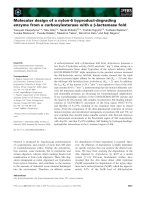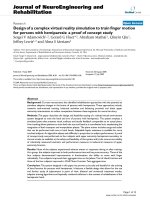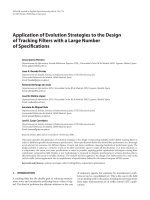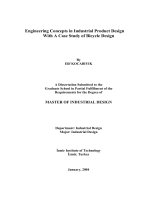Design of spring roll factory with a yield of 1500 tons per year
Bạn đang xem bản rút gọn của tài liệu. Xem và tải ngay bản đầy đủ của tài liệu tại đây (6.53 MB, 127 trang )
MINISTRY OF EDUCATION AND TRAINING
HO CHI MINH CITY UNIVERSITY OF TECHNOLOGY AND EDUCATION
FACULTY FOR HIGH QUALITY TRAINING
CAPSTONE PROJECT
FOOD TECHNOLOGY
DESIGN OF SPRING ROLL FACTORY WITH
A YIELD OF 1500 TONS PER YEAR
LECTURER: PhD. HOANG VAN CHUYEN
STUDENT: BUI NGOC XUAN LINH
PHAM MAI PHUONG
SKL 0 0 8 4 4 2
Ho Chi Minh City, December, 2021
HO CHI MINH CITY UNIVERSITY OF TECHNOLOGY AND EDUCATION
FACULTY FOR HIGH QUALITY TRAINING
DEPARTMENT OF FOOD TECHNOLOGY
GRADUATION THESIS
ID: 2021-17116017
DESIGN OF SPRING ROLL FACTORY WITH A
YIELD OF 1500 TONS PER YEAR
Advisor: HOANG VAN CHUYEN, PhD
Student:
BUI NGOC XUAN LINH – 17116017
PHAM MAI PHUONG – 17116028
HO CHI MINH CITY – DECEMBER 2021
ii
HCMC UNIVERSITY OF TECHNOLOGY AND EDUCATION
FACULTY FOR HIGH QUALITY TRAINING
DEPARTMENT OF FOOD TECHNOLOGY
MISSION OF THESIS
Name of students: Bui Ngoc Xuan Linh
Student ID: 17116017
Pham Mai Phuong
Student ID: 17116028
Major: Food Technology
1. Thesis title: Design of spring roll factory with a yield of 1500 tons per year.
2. Thesis’s ID: 2021 – 17116017
3. Mission of thesis:
-
Choosee the construction location and product comsumption.
-
Choose ingredients and builds a production process.
-
Calculate the fuel, electricity, wastes in the factory.
-
Calculate the fee, capital investment in the production process
-
Drawing A1 of the main production
-
Drawing A1 of the total factory
4. Date of assessment: 16/09/2021
5. Date of completion: 31/12/2021
6. Name of advisor: Hoang Van Chuyen, PhD
Instruction section: The whole thesis
The content and requirements of the graduation thesis have been approved by Head
of Department of Food Technology
Ho Chi Minh City, ____, _______, 2021
Chair of the program
Advisor
iii
iv
v
vi
vii
viii
ix
x
xi
ACKNOWLEDGEMENT
Therefore, we would like sincerely thank to all the lectures in charge of the
Department of Food Technology, Faculty of Chemical and Food Technology, and Ho
Chi Minh City University and Technology and Education for imparting valuable
knowledge and creating the best conditions in equipment as well as facilities for us
to complete the thesis.
We also sincerely thank our adored supervisor, Hoang Van Chuyen PhD, who has
always been enthusiastically guiding and sharing all teaching knowledge and
experience for us to accomplish this graduation thesis.
Nevertheless, we would like to send our sincere thanks to our schoolmates, for
supporting and arranging the involved experiment of the thesis.
We sincerely thank!
xii
DECLARATION
Except where there is obvious recognition and reference to the work of others, we
hereby declare that all content and material presented and involved in this thesis is
our work.
We also certify that the contents referenced in the thesis have been adequately and
accurately cited in accordance with regulations.
Ho Chi Minh, December 2021
Signature
xiii
TABLE OF CONTENTS
MISSION OF THESIS .........................................................................................................iii
ACKNOWLEDGEMENT ....................................................................................................iii
DECLARATION ................................................................................................................xiii
TABLE OF CONTENTS....................................................................................................xiii
LIST OF FIGURES ............................................................................................................. xx
LIST OF TABLES .............................................................................................................. xxi
ABSTRACT....................................................................................................................... xxv
CHAPTER 1: INTRODUCTION .......................................................................................... 1
1.1.
The neccessity of the project ................................................................................... 1
1.2.
Objectives of the project ......................................................................................... 1
1.3.
The scope of project ................................................................................................ 1
1.4.
Design content ......................................................................................................... 1
1.5.
Research Methods ................................................................................................... 1
1.6.
Scientific and practical significance of the project ................................................. 2
CHAPTER 2: ......................................................................................................................... 3
SELECTTION OF FACTORY’S LOCATION .................................................................... 3
2.1.
Design task .............................................................................................................. 3
2.2.
Choosing a location for the factory [1, 17, 18, 19] ................................................. 3
2.3.
Rationales for the selected location of the factory .................................................. 3
2.3.1.
Source of ingredient ......................................................................................... 3
2.3.2.
Consumption market ........................................................................................ 3
2.3.3.
Power – Water – Steam supply ........................................................................ 3
2.3.4.
Fuel supply ....................................................................................................... 4
2.3.5.
Drainage system and waste treatment .............................................................. 4
2.3.6.
Human Resources ............................................................................................ 4
xiv
2.3.7.
Transportation .................................................................................................. 4
CHAPTER 3: INGREDIENTS .............................................................................................. 6
3.1.
Main ingredients...................................................................................................... 6
3.1.1.
Black Tiger Shrimp .......................................................................................... 6
3.1.2.
Pork .................................................................................................................. 9
3.2.
Secondary ingredients ........................................................................................... 14
3.2.1.
Jicama ............................................................................................................ 14
3.2.2.
Taro ................................................................................................................ 15
3.2.3.
Wood-Ear Mushrooms ................................................................................... 16
3.2.4.
Carrot ............................................................................................................. 17
3.2.5.
Garlic ............................................................................................................. 18
3.2.6.
Onion ............................................................................................................. 19
3.2.7.
Spring roll wrappers....................................................................................... 19
3.3.
Additives ............................................................................................................... 19
3.3.1.
Monosodium Glutamate (MSG) .................................................................... 19
3.3.2.
Sugar .............................................................................................................. 20
3.3.3.
Oil .................................................................................................................. 20
3.3.4.
Black pepper .................................................................................................. 21
3.3.5.
Salt ................................................................................................................. 22
3.3.6.
Spring roll products ....................................................................................... 23
CHAPTER 4: MANUFACTURING ................................................................................... 24
4.1.
Processing [13, 14] ................................................................................................ 24
4.2.
Procedure............................................................................................................... 24
CHAPTER 5: ....................................................................................................................... 28
ESTABLISHMENT OF PRODUCTION PLAN ................................................................ 28
5.1.
Production plan ..................................................................................................... 28
xv
5.2.
Material balance for the product ........................................................................... 29
5.2.1.
Shrimp ............................................................................................................ 30
5.2.2.
Pork ................................................................................................................ 31
5.2.3.
Spring roll wrapper ........................................................................................ 32
5.2.4.
Jicama ............................................................................................................ 32
5.2.5.
Taro ................................................................................................................ 33
5.2.6.
Onion ............................................................................................................. 34
5.2.7.
Garlic ............................................................................................................. 35
5.2.8.
Wood – ear mushrooms ................................................................................. 35
5.2.9.
Carrot ............................................................................................................. 36
5.2.10. Salt ................................................................................................................. 37
5.2.11. Sugar .............................................................................................................. 38
5.2.12. Oil .................................................................................................................. 39
5.2.13. MSG ............................................................................................................... 39
5.2.14. Pepper ............................................................................................................ 40
CHAPTER 6: CALCULATION AND SELECTION OF MACHINES ............................. 44
6.1.
Defrost machines [21] ........................................................................................... 44
6.2.
Cutting machines [22] ........................................................................................... 45
6.3.
Vertical screw grinder [23] ................................................................................... 46
6.4.
Mixer [24] ............................................................................................................. 47
6.5.
Centrifuge [25] ...................................................................................................... 48
6.6.
Freezing equipment [26] ....................................................................................... 49
6.7.
Metal detector [27] ................................................................................................ 50
6.8.
Vacuum Packaging Machine [28] ......................................................................... 51
6.9.
Automatic spring roll machine [29] ...................................................................... 52
CHAPTER 7: ....................................................................................................................... 55
xvi
CALCULATION OF FUEL, ENERGY, WATER DEMAND OF THE FACTORY ........ 55
7.1.
Calculate electricity ............................................................................................... 55
7.1.1.
Calculation of lighting electricity .................................................................. 55
7.1.2.
Calculating electrodynamics .......................................................................... 58
7.1.3.
Determination of power factor and compensation capacity .......................... 59
7.2.
Calculate the amount of water consumed in the factory ....................................... 60
7.3.
Frozen [16] ............................................................................................................ 62
CHAPTER 8: ....................................................................................................................... 68
CALCULATIONS AND DESIGN PLANNING ................................................................ 68
8.1.
Main production workshops [1] ............................................................................ 68
8.2.
Frozen storage [16] ............................................................................................... 71
8.2.1.
Frozen meat storage room.............................................................................. 71
8.2.2.
Frozen shrimp storage room .......................................................................... 71
8.2.3.
Compressor room ........................................................................................... 72
8.2.4.
Frozen storage size......................................................................................... 72
8.3.
Freezing room [16] ................................................................................................ 72
8.4.
Agricultural storage ............................................................................................... 73
8.5.
Electromechanical workshop ................................................................................ 74
8.6.
Solid waste treatment ............................................................................................ 74
8.7.
Administrative building ........................................................................................ 74
8.8.
Canteen, hall .......................................................................................................... 75
8.9.
Medical room ........................................................................................................ 75
8.10.
Toilet.................................................................................................................. 75
8.11.
Changing room .................................................................................................. 76
8.12.
Voltage converter .............................................................................................. 76
8.13.
Waste water treatment system ........................................................................... 76
xvii
8.14.
Fuel depot .......................................................................................................... 76
8.15.
Scrap warehouse ................................................................................................ 76
8.16.
Two-wheeler garage .......................................................................................... 77
8.17.
Cars garage ........................................................................................................ 77
8.18.
Garage for trucks ............................................................................................... 77
8.19.
Water supplying................................................................................................. 77
8.20.
Fountain ............................................................................................................. 78
8.21.
Fire protection and prevention........................................................................... 78
8.22.
Security room .................................................................................................... 78
8.23.
Laundry room .................................................................................................... 78
8.24.
Laboratory ......................................................................................................... 78
8.25.
Explain the drawing of construction in total area. ............................................. 80
CHAPTER 9: ORGANIZATION – ECONOMY ............................................................... 86
9.1.
Factory organizational chart [13] .......................................................................... 86
9.2.
Fixed assets ........................................................................................................... 87
9.2.1.
Investment capital in construction ................................................................. 87
9.2.2.
Capital investment in machinery ................................................................... 88
9.3.
Direct costs ............................................................................................................ 89
9.3.1.
Cost of raw ingredients .................................................................................. 89
9.3.2.
Packaging cost ............................................................................................... 90
9.3.3.
Energy cost .................................................................................................... 90
9.4.
Salary..................................................................................................................... 90
9.5.
Social insurance cost ............................................................................................. 91
9.6.
Indirect costs ......................................................................................................... 92
9.7.
Product cost ........................................................................................................... 92
9.8.
Economic performance of invested capital ........................................................... 92
xviii
CHAPTER 10: WORK SAFETY AND HYGIENE ........................................................... 94
10.1.
Introduction to occupational safety ................................................................... 94
10.2.
Climate safety for workers ................................................................................ 94
10.3.
Safe against dust and toxic gas .......................................................................... 95
10.4.
Safety against noise and vibration ..................................................................... 95
10.5.
Lighting safety ................................................................................................... 95
10.6.
Safe to use the device ........................................................................................ 96
10.7.
Fire prevention................................................................................................... 96
10.8.
Factory cleaning. ............................................................................................... 96
CHAPTER 11: CONCLUSION .......................................................................................... 97
REFERENCES .................................................................................................................... 98
xix
LIST OF FIGURES
Figure 4.1. Manufacturing of spring roll ............................................................................. 24
Figure 6. 1 Defrost machine ................................................................................................ 44
Figure 6. 2 Cutting machines ............................................................................................... 45
Figure 6. 3 Grinder............................................................................................................... 46
Figure 6. 4 Mixer ................................................................................................................. 47
Figure 6. 5 Centrifuge .......................................................................................................... 48
Figure 6. 6 Flat belt IQF ...................................................................................................... 49
Figure 6. 7 Metal detector ................................................................................................... 50
Figure 6. 8 Vacuum packing machine ................................................................................. 51
Figure 6. 9 Spring roll making machine .............................................................................. 52
xx
LIST OF TABLES
Table 3.1. Nutritional ingedients of shrimp ........................................................................... 6
Table 3.2. Shrimp microbiota ................................................................................................ 7
Table 3.3. Requirement for microorganisms in corrugated iron [3] ...................................... 8
Table 3.4. Sensory requirements of raw shrimp .................................................................... 8
Table 3.5. Heavy metal requirements in blacl tiger shrimp ................................................... 9
Table 3.6. Nutritional ingredients of pork ............................................................................. 9
Table 3.7. Sensory requirements of fresh meat ................................................................... 11
Table 3.8. Physical and chemical requirements of fresh meat ............................................. 12
Table 3.9. Microbiological criteria of fresh meat ................................................................ 12
Table 3.10. Sensory requirements of frozen meat ............................................................... 12
Table 3.11. Physical and chemical requirements of frozen meat ........................................ 13
Table 3.12. Heavy metal residues of frozen meat................................................................ 13
Table 3.13. Microbiological requirements of frozen meat .................................................. 13
Table 3.14. Nutritional ingredients in Jicama [8] ................................................................ 14
Table 3.15. Requirements for the appearance of jicama ...................................................... 15
Table 3.16. Nutritional ingredients in Taro [8] .................................................................... 15
Table 3.17. Requirements for the appearance of taro .......................................................... 16
Table 3.18. Chemical compositions in 100g Wood – Ear Mushrooms [8] ......................... 16
Table 3.19. Nutritional ingredients in 100g carrots [8] ....................................................... 17
Table 3.20. Requirements for the appearance of carrot ....................................................... 18
Table 3.21. Requirements for the appearance of onion and garlic [8] ................................. 19
Table 3.22. Requirements for the appearance of MSG [9] .................................................. 20
Table 3.23. Requirements for the appearance of sugar [10] ................................................ 20
Table 3.24. Requirements for the appearance of black pepper ............................................ 21
xxi
Table 3.25. Requirements for physical properties of black pepper [11].............................. 21
Table 3.26. Requirements for chemical properties of black pepper .................................... 21
Table 27. Requirements for the appearance of salt [12] ...................................................... 22
Table 3.28. Physical and chemical properties of salt ........................................................... 22
Table 3.29. Sensory requirements for finished products [13].............................................. 23
Table 5. 1 The diagram of ingredients input ........................................................................ 28
Table 5. 2 Shows the number of days and shifts per month ................................................ 28
Table 5. 3 The composition of product and mixing ratio .................................................... 29
Table 5. 4 Loss of ingredients through each stage ............................................................... 30
Table 5. 5 The loss and the mass of shrimp at each stage ................................................... 30
Table 5. 6 The mass and the loss of pork at each stage ....................................................... 31
Table 5. 7 The mass and the loss of spring roll wrappers at each stage .............................. 32
Table 5. 8 The mass and the loss of jicama at each stage .................................................... 32
Table 5. 9 The mass and loss of taro at each stage .............................................................. 33
Table 5. 10 The mass and the loss of onion at each stage ................................................... 34
Table 5. 11 The mass and the loss of garlic at each stage ................................................... 35
Table 5. 12 The mass and the loss of wood – ear mushrooms at each stage ....................... 35
Table 5. 13 The mass and the loss of carrot at each stage ................................................... 36
Table 5. 14 The mass and the loss of salt at each stage ....................................................... 37
Table 5. 15 The mass and the loss of sugar at each stage .................................................... 38
Table 5. 16 The mass and the loss of oil at each stage ........................................................ 39
Table 5. 17 The mass and the loss of MSG at each stage .................................................... 40
xxii
Table 5. 18 The mass and the loss of pepper at each stage.................................................. 40
Table 5. 19 The ingredients requirement for the production line of spring rolls ................. 41
Table 5. 20 The mass of semi – products through each stage numbered from 1 to 6
(Productivity in kg/h) ........................................................................................................... 42
Table 6. 1 Defrosting machine specifications:..................................................................... 44
Table 6. 2 Specification of Cutting machine ....................................................................... 45
Table 6. 3 Specification of the Grinder ................................................................................ 46
Table 6. 4 Specifications of Mixer....................................................................................... 47
Table 6. 5 Specifications of Centrifuge ............................................................................... 48
Table 6. 6 Specifications of Flat belt Individual Quick Freezer .......................................... 49
Table 6. 7 Specifications of Metal Dectector ...................................................................... 50
Table 6. 8 Specifications of Vacuum packing machine....................................................... 51
Table 6. 9 Specifications of spring roll making machine .................................................... 52
Table 6. 10 Summary of machine and specification of the production line of shrimp and
pork spring rolls ................................................................................................................... 54
Table 7. 1 Statistical table of lighting in the main production workshop ............................ 56
Table 7. 2 General table of lighting for projects .................................................................. 56
Table 7. 3 Table of lamp power of partsin the factory ........................................................ 57
Table 7. 4 Statistics of equipment in the main production workshop.................................. 58
Table 7. 5 Table of water consumption for the main production workshop ........................ 60
xxiii
Table 7. 6 Table of water consumption for the main production workshop ........................ 61
Table 8. 1 Summary of rooms in main production workshop ............................................. 68
Table 8. 2 Statistical table of general placement of factory [1] ........................................... 78
Table 9. 1 Number of workers in main production line....................................................... 86
Table 9. 2 Number of workers in whole factory .................................................................. 87
Table 9. 3 Ingredient cost .................................................................................................... 89
xxiv
ABSTRACT
"Vietnamese spring rolls must be a unique dish to be voted one of the 50 best dishes in the
world by CNN in 2011 and one of the twelve delicious Vietnamese dishes recognized by the
Asian Record Organization in the past year," he said. Dr. Nguyen Nha said. There are some
tips to help crispy spring rolls when eaten, such as applying lemon (or vinegar) to the rice
paper before rolling or putting lemon (vinegar) in grease when frying. You can also fry and
let it cool, when eaten. Because the number of consumption is increasing and the factories
are growing more and more but not fully guaranteed the quality of the product. On the other
hand, manufacturing plants in small provinces in the country are still very limited in terms
of area as well as raw materials, output quality, so it is still necessary to import from large
provinces. Therefore, in this project, we would like to present and state the practical
requirements, design the production process and calculate the construction of a spring roll
factory with a yield of 1500 tons / year with the with advanced and modern technology
equipment to ensure the quality of output products and meet the needs of consumers in the
country and export to nearby countries.
xxv









